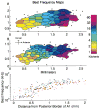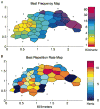Distributed representation of spectral and temporal information in rat primary auditory cortex
- PMID: 10452372
- PMCID: PMC2955153
- DOI: 10.1016/s0378-5955(99)00061-1
Distributed representation of spectral and temporal information in rat primary auditory cortex
Abstract
Modulations of amplitude and frequency are common features of natural sounds, and are prominent in behaviorally important communication sounds. The mammalian auditory cortex is known to contain representations of these important stimulus parameters. This study describes the distributed representations of tone frequency and modulation rate in the rat primary auditory cortex (A1). Detailed maps of auditory cortex responses to single tones and tone trains were constructed from recordings from 50-60 microelectrode penetrations introduced into each hemisphere. Recorded data demonstrated that the cortex uses a distributed coding strategy to represent both spectral and temporal information in the rat, as in other species. Just as spectral information is encoded in the firing patterns of neurons tuned to different frequencies, temporal information appears to be encoded using a set of filters covering a range of behaviorally important repetition rates. Although the average A1 repetition rate transfer function (RRTF) was low-pass with a sharp drop-off in evoked spikes per tone above 9 pulses per second (pps), individual RRTFs exhibited significant structure between 4 and 10 pps, including substantial facilitation or depression to tones presented at specific rates. No organized topography of these temporal filters could be determined.
Figures











References
-
- Aitkin LM, Merzenich MM, Irvine DR, Clarey JC, Nelson JE. J Comp Neurol. 1986;252:175–185. - PubMed
-
- Arnault P, Roger M. J Comp Neurol. 1990;302:110–123. - PubMed
-
- Batzri-Izraeli R, Kelly JB, Glendenning KK, Masterton RB, Wollberg Z. Brain Behav Evol. 1990;36:237–248. - PubMed
-
- Brosch M, Schreiner CE. J Neurophysiol. 1997;77:923–943. - PubMed
-
- Buonomano DV, Merzenich MM. Science. 1995;267:1028–1030. - PubMed
Publication types
MeSH terms
Grants and funding
LinkOut - more resources
Full Text Sources
Other Literature Sources

